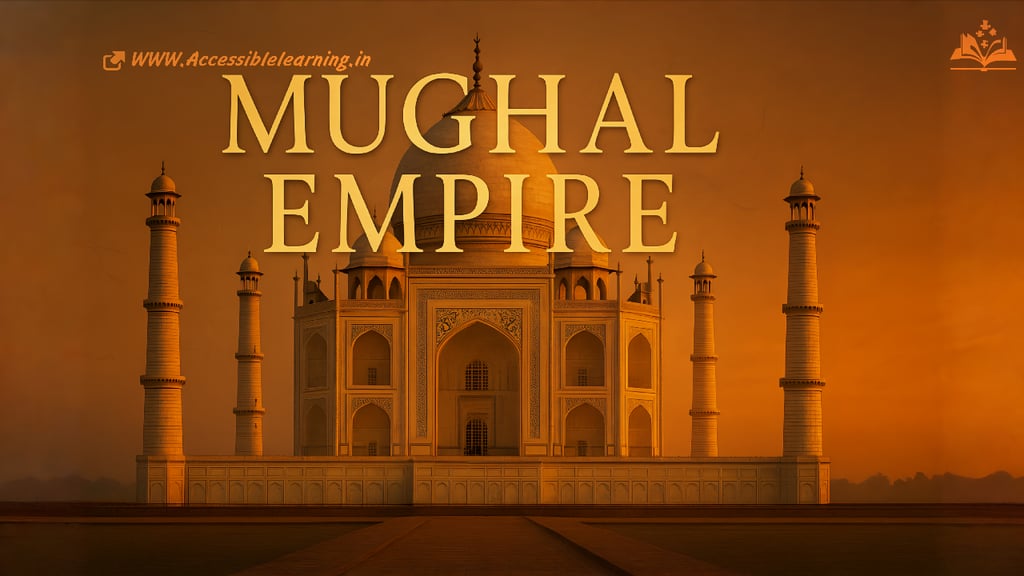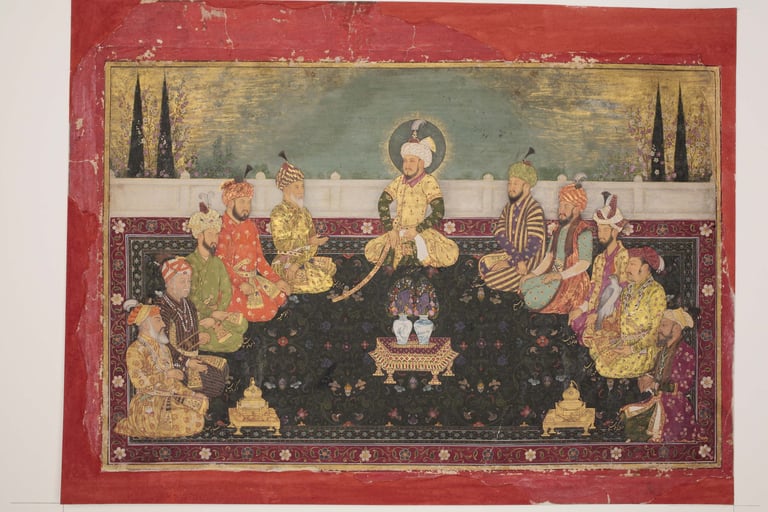
The Mughal Empire: A Complete Guide to India's Greatest Dynasty (1526-1857)
Discover the complete history of the Mughal Empire (1526-1857), India's most influential dynasty. Explore the reigns of six great emperors, architectural marvels like the Taj Mahal, administrative innovations, economic prosperity, and cultural synthesis that shaped South Asian civilization. Learn about the empire's rise, territorial expansion, decline, and lasting legacy through comprehensive analysis of politics, society, religion, and art in this definitive guide to Mughal history.
INDIAN HISTORYEMPIRES/HISTORYHISTORYDARK SIDE
Kim Shin
8/21/20257 min read


The Mughal Empire stands as one of history's most influential and enduring dynasties, ruling the Indian subcontinent for over three centuries from 1526 to 1857. This Islamic empire of Turkic-Mongol origin transformed South Asia through its sophisticated administrative systems, architectural marvels, cultural synthesis, and economic prosperity. At its zenith during the 17th century, the Mughal Empire controlled nearly the entire Indian subcontinent and accounted for approximately 25 percent of the world's gross domestic product.
Historical Background and Foundation
The Mughal Empire was established in 1526 when Babur, a descendant of both Timur and Genghis Khan, defeated Ibrahim Lodi at the First Battle of Panipat. Born Zahīr ud-Dīn Muhammad in Andijan, Fergana Valley (modern-day Uzbekistan) in 1483, Babur founded what would become one of the world's most powerful empires.
The empire emerged during a period of political fragmentation in the Indian subcontinent, where various regional kingdoms and the declining Delhi Sultanate created opportunities for new powers to establish dominance. Babur's military innovations, particularly his effective use of gunpowder technology and artillery, gave the Mughals a decisive advantage over their opponents.
The Great Mughal Emperors: Rulers Who Shaped an Empire
Babur (1526-1530): The Founder
Babur established the foundation of Mughal rule through military conquest and administrative reforms. His memoirs, the Baburnama, provide valuable insights into early Mughal history and his vision for the empire.
Humayun (1530-1540, 1555-1556): The Survivor
Despite facing temporary exile and losing control of the empire to Sher Shah Suri, Humayun's eventual restoration ensured Mughal continuity and set the stage for his successor's achievements.
Akbar the Great (1556-1605): The Empire Builder
Akbar transformed the Mughal Empire into a truly subcontinental power through military expansion, administrative innovation, and cultural synthesis. His policy of religious tolerance and the creation of the Din-i Ilahi reflected his inclusive approach to governance.
Jahangir (1605-1627): The Art Patron
Known for his love of arts and culture, Jahangir continued Akbar's policies while emphasizing artistic development and maintaining diplomatic relations with European powers.
Shah Jahan (1628-1658): The Master Builder
The builder of the Taj Mahal, Shah Jahan's reign represented the architectural pinnacle of Mughal civilization. His extensive building projects transformed the imperial capitals and created lasting monuments to Mughal grandeur.
Aurangzeb (1658-1707): The Last Great Emperor
Aurangzeb expanded the empire to its greatest territorial extent but also introduced policies that created internal tensions. His reign marked both the height and beginning of the decline of Mughal power.
Administrative System and Governance
The Mughal administrative system was remarkably sophisticated and efficient, combining Persian, Central Asian, and Indian traditions. The empire operated through a centralized bureaucracy with the emperor at its apex, supported by various administrative ranks and officials.
The mansabdari system formed the backbone of Mughal administration, where officials held military and civil ranks called mansabs. This system ensured efficient governance across the vast empire while maintaining loyalty to the central authority. Provincial governors, known as subahdars, administered the various regions while remaining accountable to the imperial court.
The Mughal Empire maintained multiple imperial capitals throughout its existence, including Agra, Delhi, Lahore, and Fatehpur Sikri. Power often shifted between these centers based on political, military, and strategic considerations, demonstrating the empire's adaptability and administrative flexibility.

Economic Foundation and Trade Networks
The Mughal economy was fundamentally agrarian, with agriculture serving as the primary economic activity and land revenue as the main source of imperial income. The empire's agricultural productivity supported a population that constituted a significant portion of the world's demographic total.
Trade flourished under Mughal rule, with the empire serving as a crucial link between Asian and European commercial networks. The introduction of new crops, including tobacco, maize, chili, pineapple, grafted mangoes, potato, tomato, and guava, revolutionized agricultural practices and dietary habits across the subcontinent.
Industrial activities, particularly indigo cultivation and sericulture (silk production), became important economic sectors that attracted European traders and contributed to the empire's wealth. The Mughal monetary system, based on silver and gold coins, facilitated extensive commercial transactions across vast distances.
Architectural Legacy and Cultural Achievements
Mughal architecture represents one of the most distinctive and influential building traditions in world history. The synthesis of Persian, Central Asian, and Indian architectural elements created a unique style characterized by grand scale, geometric precision, and decorative sophistication.
The Taj Mahal stands as the most famous example of Mughal architecture, but numerous other monuments, including the Red Fort in Delhi, Fatehpur Sikri, and various tombs and gardens, demonstrate the empire's architectural achievements. These structures employed advanced engineering techniques and innovative design principles that influenced subsequent architectural developments.
Cultural synthesis under Mughal rule produced remarkable achievements in literature, painting, music, and scholarship. The imperial court patronized artists, poets, and intellectuals from various backgrounds, creating an environment where different traditions could interact and evolve.
Religious Policies and Social Structure
The Mughal approach to religious governance evolved significantly throughout the empire's history. Early rulers like Akbar promoted religious tolerance and inclusive policies, while later emperors like Aurangzeb implemented more orthodox Islamic practices.
The empire's religious policies directly affected its relationship with the diverse population of the Indian subcontinent. The success of Mughal rule often depended on maintaining a balance between Islamic principles and accommodation of local religious traditions.
Social structure under the Mughals reflected both Islamic hierarchical principles and existing Indian social arrangements. The imperial court attracted nobles and administrators from various ethnic and religious backgrounds, creating a cosmopolitan ruling class.
Military Organization and Technology
Mughal military success depended on several factors, including superior technology, effective organization, and strategic leadership. The early adoption of gunpowder weapons, particularly artillery and matchlock firearms, provided decisive advantages in key battles.
The imperial army combined various military traditions, incorporating Turkic-Mongol cavalry tactics, Persian administrative methods, and Indian military knowledge. This synthesis created a formidable fighting force capable of conquering and controlling vast territories.
Military technology continued to evolve throughout the empire's history, with Mughal forces adapting to new challenges and incorporating innovations from various sources, including European military advisors and weapon manufacturers.


Decline and Dissolution
The decline of the Mughal Empire resulted from multiple interconnected factors that gradually weakened imperial authority and territorial control. Economic pressures, including expensive military campaigns and administrative costs, strained imperial resources.
Political fragmentation emerged as regional governors and local rulers increasingly asserted independence from central authority. The rise of powerful regional states, particularly the Marathas, challenged Mughal supremacy and carved away imperial territories.
European colonial expansion, initially through trade relationships, eventually evolved into political and military intervention. The British East India Company gradually assumed control of imperial functions, culminating in the formal dissolution of the empire in 1857 following the Indian Rebellion.
Contemporary Relevance and Historical Debates
Modern scholarly research continues to reveal new insights about Mughal history, governance, and cultural impact. Recent studies have emphasized the empire's role in the early modern global economy and its sophisticated administrative systems.
Contemporary political developments in South Asia have renewed interest in Mughal history, with various groups interpreting the empire's legacy differently. These debates reflect ongoing discussions about cultural identity, religious tolerance, and historical memory in modern India.
The Mughal Empire's influence extends beyond historical significance to contemporary cultural expressions, including architecture, arts, cuisine, and language. Understanding this legacy remains crucial for comprehending modern South Asian civilization and its global connections.
The Mughal Empire represents one of history's most remarkable examples of successful multicultural governance and administrative innovation. From its establishment by Babur in 1526 to its dissolution in 1857, the empire demonstrated how effective leadership, cultural synthesis, and administrative sophistication could create lasting political and cultural achievements.
The empire's legacy extends far beyond its military conquests and territorial control. The Mughal synthesis of diverse cultural traditions created enduring contributions to architecture, arts, literature, and governance that continue to influence contemporary South Asian civilization. Understanding the Mughal Empire remains essential for comprehending the historical foundations of modern South Asia and its place in global history.
The empire's experience with religious diversity, cultural integration, and administrative challenges offers valuable insights for contemporary discussions about multicultural societies and effective governance. As one of the early modern world's most successful empires, the Mughal Empire demonstrates both the possibilities and limitations of imperial governance in diverse societies.
Through its remarkable three-century history, the Mughal Empire transformed the Indian subcontinent while creating a lasting legacy that continues to shape the region's identity, culture, and historical consciousness. The empire's story remains a testament to the complex interplay between political power, cultural creativity, and historical change that defines human civilization.


Frequently Asked Questions
Q: What was the Mughal Empire, and when did it exist?
The Mughal Empire was an Islamic dynasty of Turkic-Mongol origin that ruled most of northern and central India from 1526 to 1857. Founded by Babur after his victory at the Battle of Panipat, the empire lasted for 331 years and became one of the largest and most influential empires in world history.
Q: Who were the most important Mughal emperors?
The six Great Mughal emperors were Babur (founder), Humayun (restoration), Akbar the Great (expansion and tolerance), Jahangir (cultural patron), Shah Jahan (architectural master), and Aurangzeb (territorial peak). Each emperor contributed distinct elements to the empire's development and legacy.
Q: How large was the Mughal Empire at its peak?
At its zenith under Aurangzeb in the late 17th century, the Mughal Empire controlled nearly the entire Indian subcontinent, extending from Kashmir in the north to the Deccan plateau in the south, and from Bengal in the east to Afghanistan in the west. The empire encompassed approximately 4 million square kilometers.
Q: What was the Mughal Empire's economic significance?
The Mughal Empire accounted for approximately 25 percent of the world's gross domestic product during its peak period. The empire's wealth derived primarily from agriculture, trade, and manufacturing, making it one of the world's wealthiest regions during the early modern period.
Q: How did the Mughal Empire influence Indian culture?
The Mughal Empire created a lasting cultural synthesis by blending Persian, Central Asian, and Indian traditions. This fusion produced distinctive achievements in architecture, literature, painting, music, and cuisine that continue to influence South Asian culture today.
Q: What caused the decline of the Mughal Empire?
The empire's decline resulted from multiple factors, including economic strain from military campaigns, political fragmentation as regional powers asserted independence, administrative corruption, and eventually European colonial intervention, particularly by the British East India Company.
Q: What is the Mughal Empire's architectural legacy?
Mughal architecture created some of the world's most famous monuments, including the Taj Mahal, Red Fort, and Fatehpur Sikri. The distinctive Mughal architectural style combined Islamic, Persian, and Indian elements and continues to influence building design in South Asia.
Q: How did the Mughal Empire end?
The Mughal Empire formally ended in 1857 when the British exiled the last emperor, Bahadur Shah Zafar, following the Indian Rebellion. By this time, the empire had already lost most of its territory and power to regional rulers and British colonial expansion.
Subscribe to our newsletter
All © Copyright reserved by Accessible-Learning
| Terms & Conditions
Knowledge is power. Learn with Us. 📚


